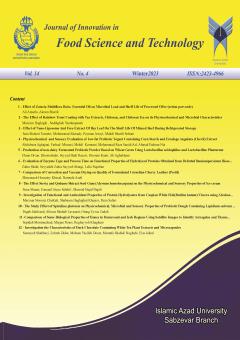Manuscript ID : JFST-1908-1562 (R3)
Visit : 327
Page: 83 - 94
10.30495/jfst.2021.1875940.1562
20.1001.1.24234966.1401.14.4.6.3
Article Type:
Original Research
Evaluation of Enzyme Type and Process Time on Functional Properties of Hydrolyzed Proteins Obtained from Defatted Buniumpersicum Bioss. Pressed Cake
Subject Areas :
Zahra Shahi
1
,
Seyyedeh Zahra Sayyed-Alangi
2
*
,
Leila Najafian
3
1 - دانشجوی دکتری، گروه علوم و صنایع غذایی، واحد ساری، دانشگاه آزاد اسلامی، ساری، ایران
2 - دانشیار، گروه شیمی، واحد آزادشهر، دانشگاه آزاد اسلامی، آزادشهر، ایران..
3 - استادیار، گروه علوم وصنایع غذایی، واحد ساری،دانشگاه آزاد اسلامی، ساری، ایران
Received: 2019-08-29
Accepted : 2020-06-28
Published : 2022-12-22
Keywords:
References:
Abeyrathne, E. D., Lee, H. Y., Jo, C., Suh, J. W. and Ahn, D. U. 2016. Enzymatic hydrolysis of ovomucin and the functional and structural characteristics of peptides in the hydrolysates. Food Chemistry, 192:107-113.
Ahmadi, F., Kadivar, M. and Shahedi, M. 2007. Antioxidant activity of in model and food systems. Food Chemistry, 105: 57-64.
Al-Jasass, F. M. and Al-Jasser, M. S. 2012. Chemical composition and fatty acid content of some spices and herbs under Saudi Arabia conditions. The Scientific World Journal, 2012.
Aluko, R. E. and Monu, E. 2003. Functional and bioactive properties of quinoa seed protein hydrolysates. Journal of Food Science, 68: 1254-1258.
Balasundram, N., Sundram, K. and Samman, S. 2006. Phenolic compounds in plants and agri-industrial by-products: Antioxidant activity, occurrence, and potential uses. Food Chemistry, 99(1): 191-203.
Bradford, M. M. 1976. A rapid and sensitive method for the quantitation of microgram quantities of protein utilizing the principle of protein-dye binding. Analytical Biochemistry, 72: 248-254.
Chen, C., Chi, Y. J., Zhao, M. Y. and Xu, W. 2012. Influence of degree of hydrolysis on functional properties, antioxidant and ACE inhibitory activities of egg white protein hydrolysate. Food Science and Biotechnology, 21: 27-34.
Chen, H. M., Muramoto, K., Yamauchi, F. Fujimoto, K. and Nokihara, K., 1998. Antioxidative properties of histidine-containing peptides designed from peptide fragments found in the digests of a soybean protein. Journal of Agricultural and Food Chemistry, 46: 49-53.
Cumby, N., Zhong, Y., Naczk, M. and Shahidi, F. 2008. Antioxidant activity and water-holding capacity of canola protein hydrolysates. Food Chemistry, 109: 144-148.
Feyzi, S., Varidi, M., Zare, F. and Varidi, M. J. 2018. Effect of drying methods on the structure, thermo and functional properties of fenugreek (Trigonellafoenumgraecum) protein isolate. Journal of the Science of Food and Agriculture, 98 (5):1880-1888.
Jamdar, S. N., Rajalakshmi, V., Pednekar, M. D., Juan, F., Yardi, V. and Sharma, A. 2010. Influence of degree of hydrolysis on functional properties, antioxidant activity and ACE inhibitory activity of peanut protein hydrolysate. Food Chemistry, 121: 178-184.
Klompong, V., Benjakul, S., Kantachote, D. and Shahidi, F. 2007. Antioxidative activity and functional properties of protein hydrolysate of yellow stripe trevally (Selaroidesleptolepis) as influenced by the degree of hydrolysis and enzyme type. Food Chemistry, 102 (4): 1317-1327.
Nalinanon, S., Benjakul, S., Kishimura, H. and Shahidi, F. 2011. Functionalities and antioxidant properties of protein hydrolysates from the muscle of ornate threadfin bream treated with pepsin from skipjack tuna. Food Chemistry, 124: 1354-1362.
Peña-Ramos, E. A. and Xiong, Y. L. 2003. Whey and soy protein hydrolysates inhibit lipid oxidation in cooked pork patties. Meat Science, 64: 259-263.
Peñta‐Ramos, E. A. and Xiong, Y. L. 2002. Antioxidant activity of soy protein hydrolysates in a liposomal system. Journal of Food Science, 67: 2952-2956.
Pihlanto, A. 2006. Antioxidative peptides derived from milk proteins. International Dairy Journal, 16:1306-1314.
Ramadan, M. F. 2007. Nutritional value, functional properties and nutraceutical applications of black cumin (Nigella sativa L.): an overview. International Journal of
Food Science &Technology, 42(10): 1208-1218.
Sakanaka, S. and Tachibana, Y. 2006. Active oxygen scavenging activity of egg-yolk protein hydrolysates and their effects on lipid oxidation in beef and tuna homogenates. Food Chemistry, 95: 243-249.
Sarmadi B. H. and Ismail A. 2010. Antioxidative peptides from food proteins: a review. Peptides, 31(10):1949-1956.
Tong, L. M., Sasaki, S., Mc Clements, D. J. and Decker, E. A. 2000. Mechanisms of the antioxidant activity of a high molecular weight fraction of whey. Journal of Agricultural and Food Chemistry, 48: 1473-1478.
Tsumura, K., Saito, T., Tsuge, K., Ashida, H., Kugimiya, W. and Inouye, K. 2005. Functional properties of soy protein hydrolysates obtained by selective proteolysis. LWT-Food Science and Technology, 38: 255-261.
Van der Ven, C., Gruppen, H., de Bont, D. B. and Voragen, A. G. 2002. Correlations between biochemical characteristics and foam-forming and-stabilizing ability of whey and casein hydrolysates. Journal of Agricultural and Food Chemistry, 50: 2938-2946.
Wu, H. C., Chen, H. M. and Shiau, C. Y. 2003. Free amino acids and peptides as related to antioxidant properties in protein hydrolysates of mackerel (Scomberaustriasicus). Food Research International, 36: 949-957.
You, L., Zhao, M., Cui, C., Zhao, H. and Yang, B. 2009. Effect of degree of hydrolysis on the antioxidant activity of loach (Misgurnusanguillicaudatus) protein hydrolysates. Innovative Food Science and Emerging Technologies, 10: 235-240.
You, L., Zhao, M., Regenstein, J. M. and Ren, J. 2010. Changes in the antioxidant activity of loach (Misgurnusanguillicaudatus) protein hydrolysates during a simulated gastrointestinal digestion. Food Chemistry, 120: 810-816.
_||_
Related articles

